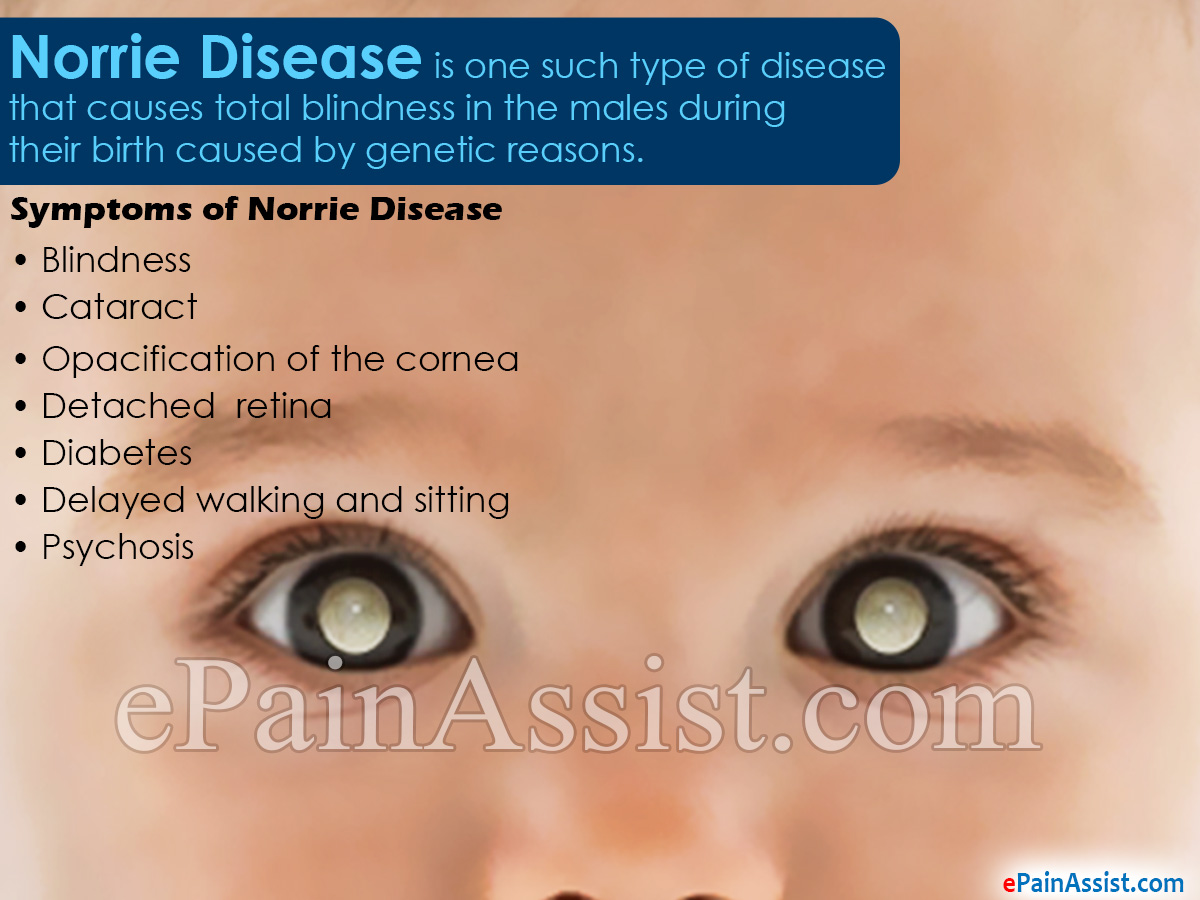Newborns right after birth are very vulnerable to various health conditions. Some are genetic, some environment induced while some others are due to birth related complications. Norrie Disease is one such type of disease that causes total blindness in the males during their birth caused by genetic reasons. It is supposed to be a rare disease and it is found that those suffering from Norrie Disease experience hearing problems, and also their development is retarded or is very slow. They also have some kind of behavioral abnormalities. Norrie Disease has been found to run in the families because it is carried to the next generation by the carrier with the help of X- chromosomes genes.

It is observed that healthy mothers are the carriers of the mutated gene that produces this disease. She passes on these genes to the sons who get affected with Norrie disease. There are chances that some of the sons may not get these genes and will grow perfectly healthy. It is also found that there are chances that 50 percent of the mothers have the risk of being the carriers and pass on the X–chromosomes which are mutated.
The fact is that sometimes the daughter may receive the mutated chromosome from the mother and she can be the carrier. This again has 50 percent chance of passing the genes to their sons. That is one of the reasons why it is said that Norrie’s disease is a rare type of disease.
Symptoms of Norrie Disease
The most important characteristic of Norrie Disease is blindness right after birth. The other symptoms of Norrie Disease vary from individual to individual and only the doctors will be in a position to diagnose the disease.
Norrie’s disease is a silent killer disease. The symptoms in the early stage can help to take care of the child.
Some of the Symptoms of Norrie Disease are
- Blindness: – because of recurrent vitreous hemorrhages
- Cataract: – caused by the mass behind the eye lens to obstruct vision
- Opacification of the cornea: – causes shrunken eyeball, retinal malformation and retinal folds
- Detached retina
- Diabetes
- Delayed walking and sitting
- Psychosis
Prognosis of Norrie’s Disease
The prevalence and occurrence rate of Norrie Disease are not known yet as it is very rare. However, it has been reported to occur in all groups of people and only the male child is affected by Norrie Disease whereas the female child becomes the carrier.
Causes of Norrie Disease
Very often the researchers have found that Norrie Disease is generally inherited as X – linked genetic disorder that is due to the abnormal gene on the X – chromosomes is turned off which means the chromosomes present on those genes are not activated. It usually happens in the males only. These chromosomes if present in the females then, they become the carrier of the disease but they are not affected with the disease.
Researchers have found that Norrie disease occurs because of the mutations of the genes located on the X-chromosomes present in the nucleus of the human cell, which carries the genetic information for every single individual.
Mutations in the NDP gene on the chromosome cause Norrie disease which is inherited in an X-linked recessive pattern. This is the reason why mostly the boys are affected with Norrie Disease.
Pathophysiology of Norrie Disease
According to the researchers it is found that the X-linked recessive disorder causes ocular atrophy, mental retardation, deafness and dysmorphic features in the new born. In some boys it is found that there is absence of monoamine oxidase which are known to be type-A and type-B activity in some male child with chromosome deletions. The findings have suggested that abnormal activity or the imbalance between serotonin and other neurotransmitter levels can be the reason of pathogenesis of human cataplexy.
Diagnosis of Norrie Disease
Norrie disease is suspected based on the detailed study of the patient history, through the clinical evaluation and identifying the characteristics of findings. There are chances of family history that supports the X – linked inheritance. It can be confirmed with the help of molecular genetic testing where the doctor can come to know about the mutation in the defective gene present. Such information can be available by doing the testing at the respective clinical testing laboratories.
Based on certain symptoms it is diagnosed whether the child is having Norrie Disease. The symptoms are as follows:
- As soon as the child is born the eyeballs of the child shrinks
- There can appear cloudiness in the eye lens
- Shrinkage in the pupils
- Iris of the eyes may shrink
- Sometimes there is loss of hearing in the child
- Delay in other developments such as sitting and walking.
All the above symptoms are sufficient to confirm the diagnosis of the Norrie Disease.
What are the Complications Associated with Norrie Disease?
The main complications associated with Norrie’s disease are:
- Learning disability
- Cataracts
- Retinal pathology.
All of them are the secondary conditions of complications in this disease and sometimes these complications are not clear or arbitrary.
What is the Treatment for Norrie Disease?
It is found that there is no specific treatment that could treat Norrie’s disease as it is a genetic disorder. There is also no way to discontinue or stop or reverse the loss of sight and also hearing. The only medical treatments that can be given are for the other problems associated with Norrie Disease like respiration or breathing difficulties and in some case digestion problem.
A child born with Norrie’s disease would need special attention such as special education because of sight and hearing impairments. Moreover, specialized attention is also needed as many children will have mental retardation.
